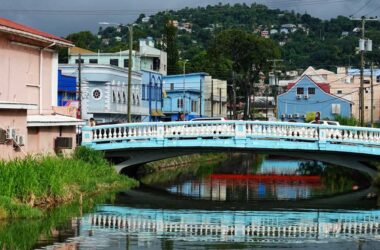
THE government of St. Lucia has unbridled the La Woz cultural flower festival in 2022. And the populace looks forward to great festivals in the near future.
Growing up in the Marchand Community several decades ago, I looked upon the La Rose Flower Festival as a celebration for the older folks seventy years and over, because these were the people I saw participating in the flower festival. And I often heard those elders lament the fact that they have tried or are still trying to bring the younger folks along.
But the celebration in 2022 has reflected a different thinking. Scores of young people participated in the activity this year. And many more came to view the spectacle.
The church of the Immaculate Conception of the Archdiocese of Castries attracted hundreds of participants and supporters of the La Rose Flower Festival. The day began with a church service at the cathedral followed by presentation in Constitution Park and The William Peter Boulevard.
Groups from around the island were decked in well designed outfits of pink and red creating a sparkle in the city. The La Rose songs came in very quick succession.
The La Woz Flower Festival is a Catholic Festival. The flower festival obtained its name from Saint Rose of Lima.
But what exactly is the historical tradition of the La Woz Festival which is a cultural centrepiece of St. Lucia.
St. Rose of Lima was a Spanish girl of Santa Rosa de Lima whose original name was Isabel Flores de Olivia. She was born in Lima Peru on 20th April, 1586, exactly 436 years ago. Isabel died on 24th August, 1617 in Lima at the age of 31 years.
Isabel was canonized by the Roman Catholic Church on 23rd of August 1671. She was born in a noble family and was called then Rosa.
Rosa is a Spanish name for Rose. Rosa/Isabel always showed an expression of penitence or penance. By penance I mean voluntary self punishment inflicted on oneself as an outward expression of repentance for having done wrong. Her feast day is 23rd August which was previously celebrated on 30th August.
In St. Lucia, we have kept the feast day on 30th August every year.
Rosa lived a spiritual life at a young age. Her mother wanted her to marry and initially refused to allow her daughter to pursue a religious life. In order to prevent men from pursuing a relationship with her with a view to marriage, the beautiful Rosa cut off her hair and blistered her skin with hot peppers. The struggle between herself and her mother continued for 10 years, after which Rosa made a perpetual vow of virginity.
In 1606 her mother relented and allowed Rosa to become a Dominican Sister. But her mother did not allow her to live in a convent. Instead Rosa chose strict enclosure and contemplation and went to live in a hut in the family garden where she lived a life of isolation. She slept only a few hours a night. She regularly wore a crown of thorns and practiced fasting.
Rosa was devoted to the sick and hungry in the community and often brought them to her hut to care for them.
Rosa was skilled in needlework and sold her fine lace, embroidery and flowers she grew in the garden to help her family and to raise funds for the poor.
Rosa’s funeral was an occasion of public honour and many miracles were said to have occurred after her death. She was beatified in 1668 by Pope Clement IX, and declared a patron of Lima. She was actually canonized by Pope Clement X, who proclaimed her the patron Saint of South America, the Indies, and the Philippines.
Now I do not want you to be confused between Pope Clement IX and Pope Clement X. Just before the installation of a new pope, the pope to be installed selects a missionary name. He may take the missionary name of the pope before him or a another name completely. For example Pope Pius the XI and Pope Pius the XII; Pope John Paul I and Pope John Paul II.
Now what do I mean by canonized. It means that she was actually made a saint in 1671 three years after she was beatified. This is the stage before she was made a Saint. She is now called St. Rose of Lima or St. Rose de Lima.
The St. Lucia Labour Party, prior to the 2021 General Elections promised to strengthen the Arts, culture and Creative Industry by restructuring the state-run cultural agencies into one entity to achieve stronger synergy and efficiency and alignment to national development goals.
Judging from what I am witnessing on the ground that structure is already taking root. We have seen a well organized carnival, a delightful Emancipation Day activity, and very recently, a participatory La Woz Festival with increasing numbers.
I can declare now that St. Lucia would be the home for five major cultural activities and the envy of the Caribbean Islands. The activities are, Carnival, Emancipation Day, La Rose Festival. La Marguerite Festival, Creole Day, or Jounen Kweyol. The committee handling these activities will make us proud to be St. Lucians.
I would like to insist that these activities form an integral part of the school curriculum in addition to the teaching of Kweyol in our schools. Gradually we would be lead to a culture without boundary. By that I mean it will be all embracing; bringing all our people together.
Indeed, we have a determined Minister of Culture and creative Minister of Education who can make things happen in our Fair Helen.
Finally, we have an effective leader and Prime Minister who is providing the kind of leadership and support to members of his government.
My grand children and great grand children will have much to be proud of and participate in, even though I am long gone.














